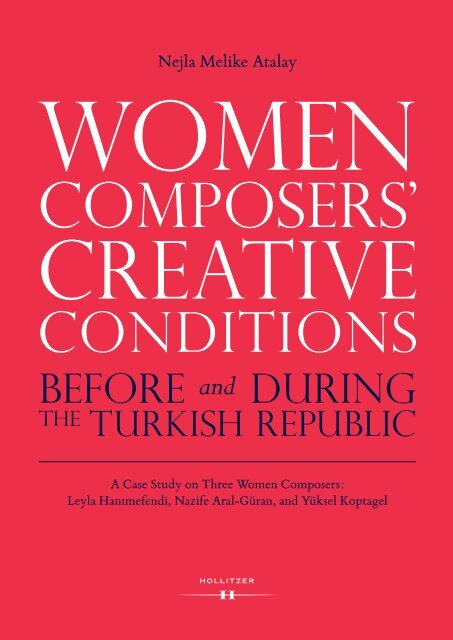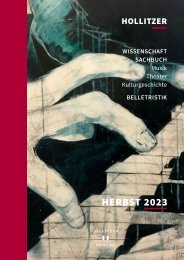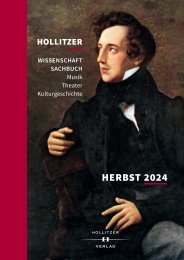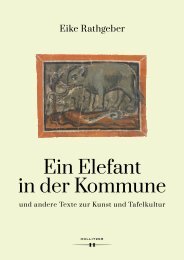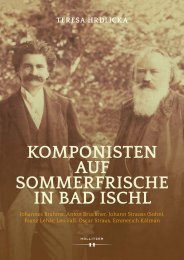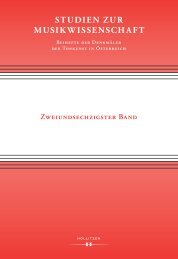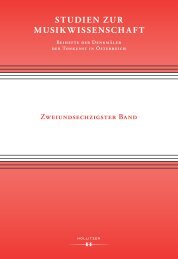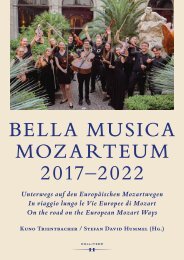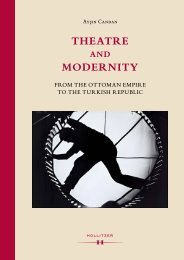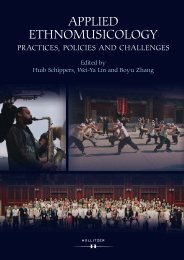Create successful ePaper yourself
Turn your PDF publications into a flip-book with our unique Google optimized e-Paper software.
Nejla Melike Atalay<br />
WOMEN<br />
COMPOSERS’<br />
CREATIVE<br />
CONDITIONS<br />
BEFORE and DURING<br />
THE<br />
TURKISH REPUBLIC<br />
A Case Study on Three <strong>Women</strong> <strong>Composers</strong>:<br />
Leyla Hanımefendi, Nazife Aral-Güran, and Yüksel Koptagel
<strong>Women</strong> <strong>Composers</strong>’ Creative Conditions<br />
Before and During the Turkish Republic
Nejla Melike Atalay<br />
<strong>Women</strong> <strong>Composers</strong>’<br />
Creative Conditions Before and<br />
During the Turkish Republic<br />
A Case Study on Three <strong>Women</strong> <strong>Composers</strong>:<br />
Leyla [Saz] Hanımefendi (1850?–1936), Nazife Aral-Güran (1921–1993) and<br />
Yüksel Koptagel (b.1931)
Printed with financial support of:<br />
mdw – Universität für Musik und darstellende Kunst Wien<br />
Nejla Melike Atalay: <strong>Women</strong> <strong>Composers</strong>’ Creative Conditions Before and During the Turkish Republic.<br />
A Case Study on Three <strong>Women</strong> <strong>Composers</strong>: Leyla [Saz] Hanımefendi (1850?–1936), Nazife Aral-Güran<br />
(1921–1993) and Yüksel Koptagel (b.1931)<br />
© Hollitzer Verlag, Vienna, 2021<br />
Frontispiece:<br />
Leyla Hanımefendi, Nazife Aral-Güran and Yüksel Koptagel,<br />
by Zekerya Saribatur, Vienna, 2020.<br />
All rights reserved.<br />
Cover and layout: Nikola Stevanović<br />
Printed and bound in the EU<br />
www.hollitzer.at<br />
ISBN 978-3-99012-850-3
To my one and only beloved family
CONTENTS<br />
Acknowledgements<br />
Preliminary Remarks on Various Uses<br />
of the Ottoman/Turkish Language<br />
List of Abbreviations<br />
List of Examples<br />
List of Tables<br />
List of Figures<br />
List of Visuals<br />
Introduction – Initial Steps: On my Background and Motivation for the<br />
Research – Scope of the Research – The <strong>Composers</strong>: Why These Three? –<br />
On Methodology and Foundational Factors – Overview of Chapters<br />
11<br />
13<br />
14<br />
15<br />
15<br />
16<br />
16<br />
19<br />
CHAPTER I<br />
Terminological Definitions in Ottoman/Turkish Music<br />
1.1. Defining and Categorising Turkish Music, and the Problem of Genre<br />
1.2. Genre – Polyphonic Music of Turkey (Türkiye’nin Çoksesli Müziği) –<br />
Polyphony and Çokseslilik – Definition of Polyphony and Çokseslilik<br />
in Turkish Music Encyclopaediae and Other Reference Books<br />
1.3. Categorising – Non-Turkish Approach to Polyphonic Music of<br />
Turkey and its Place in Categorising<br />
1.4. The Polyphonic Music of Turkey in Turkish Music Historiography<br />
and Music Literature – Alaturka and Alafranga<br />
1.5. Conclusion<br />
33<br />
34<br />
41<br />
46<br />
59<br />
7
CHAPTER II<br />
Institutionalisation of Western Music in the Ottoman Empire<br />
and in the Turkish Republic in Music Historiography<br />
2.1. The Introduction of Western Music to the Ottoman Empire as an<br />
Institution: Its Function and Status<br />
2.2. Muzika-i Hümayûn – On Style and Repertoire – Some Hybrid Trials<br />
in Education Model and Practice<br />
2.3. A Fanfare Orchestra Consisting of <strong>Women</strong> in the Palace<br />
2.4. Music Schools in the Ottoman Empire<br />
2.5. The Impact of Non-Muslim Ottomans and Non-Ottoman Citizens<br />
on the Adoption of Western Music in the Ottoman Empire<br />
2.6. Alafranga Life and Music<br />
2.7. Instrumentalisation of Western Music in Turkish Republic –<br />
Expectations and Steps Taken<br />
2.8. The Contribution of European Experts in the Newly Established or<br />
Restructured Music Institutions of the Republic – On the Multiplicity<br />
of Écoles, Methods and Styles that Appeared in the Ottoman Empire<br />
and the Turkish Republic<br />
2.9. Conclusion<br />
61<br />
62<br />
71<br />
74<br />
75<br />
76<br />
77<br />
85<br />
92<br />
CHAPTER III<br />
<strong>Women</strong> Musicians of Late Ottoman Istanbul<br />
3.1. Inside the Palace – Writing about the Imperial Harem (Harem-i<br />
Hümâyun) – Leyla [Saz] Hanımefendi’s memories: The Imperial<br />
Harem of the Sultans – Spaces allocated for Music in the Ottoman<br />
Palace and the Imperial Harem – <strong>Women</strong> Musicians in the Ottoman<br />
Palaces – On the Musical Training of Dynasty Members – A<br />
Glimpse Inside the Palace: The <strong>Women</strong>’s Orchestra in the Palace –<br />
Pianist and Composer Sultans – Dédié a Sa Majeste Imperiale Le Sultan<br />
[Compositions Dedicated to the Sultans] – On Visiting Musicians and<br />
the Favours Bestowed upon Them<br />
3.2. Outside the Palace – Madam Hacı Foti: Attempting to establish a music<br />
school specially for women in Istanbul – Advertisements for <strong>Women</strong><br />
Teaching Piano – Some Music Professors Residing in Istanbul found<br />
in the Annuaire Oriental<br />
3.3. Music Scores by <strong>Women</strong> Published in Istanbul in the Late Nineteenth<br />
and Early Twentieth Centuries – Madame Herzmaińska (aka Irma<br />
Herzmaińska) and her Album – On Some Compositions by <strong>Women</strong> in<br />
95<br />
120<br />
8
the Late Nineteenth and Early Twentieth Centuries – Fatma Zinnur<br />
Hanım – Victoire de Tchataldja (Çatalca Muzafferiyeti) – İhsan Raif<br />
Hanım: La Voix de la Liberte – İhsan Sabri Hanım: Pour ma Patrie [For<br />
my Country] – Leyla [Saz] Hanımefendi: La Gloir [sic] – Emine Şayan<br />
Hanım: Rhum des [sic] Deutschen Arme [sic] [The Victorious March<br />
for the German Army] – On the Ottoman <strong>Women</strong> who Received<br />
Music Education in Germany in the Twentieth Century – A General<br />
Framework for the <strong>Women</strong> who Travelled to Europe for Music<br />
Education on a Scholarship<br />
3.4. Conclusion<br />
128<br />
148<br />
CHAPTER IV<br />
Conditions of Production<br />
4.1. Circumstances determining the conditions: Socio-political environment<br />
– Tanzimat [Reorganisation] – Modernisation Approaches under<br />
Ottoman/Turkish Regimes and Their Discussion in Present Day Historiography<br />
– Tanzimat in Ottoman Historiography – Other façades of<br />
Tanzimat – Toward a National Awareness – On <strong>Women</strong>’s Movement in<br />
the Late Ottoman Period and <strong>Women</strong>’s Magazines<br />
4.2. Early Republican Era (1923–1950) – Republic and Caliphate –<br />
Conditions of Making of a Kemalist Woman – Nazife Aral-Güran:<br />
Being of a Woman Musician of the Republic<br />
4.3. Transition to Multi-Party regime (1945–1980) –<br />
[Never-ending] Censorship and its Effects – Expanding the Borders<br />
4.4. Conclusion<br />
151<br />
180<br />
200<br />
209<br />
CHAPTER V<br />
Conditions of Production II (on the Personal Level)<br />
5.1. Family Background as a Factor Determining Conditions – Leyla [Saz]<br />
Hanımefendi (1850?–1936) – Children of Leyla [Saz] Hanımefendi<br />
and Sırrı Paşa – Nazife Aral-Güran (1921–1993) – On Family and Last<br />
Names – Family and Social Status – Nazife Aral-Güran’s marriage<br />
to İsmail Yılmaz Güran (1952) – Yüksel Koptagel (b. 1931) – Yüksel<br />
Koptagel’s marriage to Danyal Kerven (1964)<br />
5.2. Educational Background as a Factor Determining Conditions<br />
– Circumstances Determining the Conditions: (Educational<br />
Background) – Leyla [Saz] Hanımefendi – Leyla Hanımefendi’s Meşks<br />
– On Piano Meşk – Nazife Aral-Güran – Certificate for Teaching<br />
211<br />
9
Music – Interactivity on Multiple Levels – Yüksel Koptagel – Towards<br />
Being a Pianist – Being a Performer who Composes – Music Writer<br />
5.3. Conclusion<br />
243<br />
272<br />
CHAPTER VI<br />
Music Historiography in Turkey Focusing on ‘<strong>Women</strong> <strong>Composers</strong>’<br />
6.1. Gender Perspectives on the ‘Issue of <strong>Women</strong>’ in Music Studies in<br />
Turkey – An Overview of Studies on <strong>Women</strong> <strong>Composers</strong> in the<br />
Ottoman Empire/Turkish Republic<br />
6.2. The Biases against <strong>Women</strong> <strong>Composers</strong> in Turkey – Hikmet Şimşek:<br />
“Woman and Music. The Woman in Turkish Music” – Faruk Yener:<br />
“On <strong>Women</strong> and the Art of Composing” – Fazıl Say: “Improvisation 2” –<br />
Yılmaz Öztuna: “Leyla Saz”<br />
6.3. Approaches to Concepts of Dehâ [Ingenuity] and Dâhi [Genius]<br />
6.4. Conclusion<br />
275<br />
286<br />
330<br />
333<br />
CHAPTER VII<br />
Places of Production and Creation<br />
7.1. Thinking of Space and Place<br />
7.2. Mansions (Konak) and Pavilions (Köşk’) – Defining Konak and<br />
Köşk – Mansion and Pavilion as a Space – Remembrance of Leyla<br />
Hanımefendi’s Burnt Pavilion (Yanan Köşkümün Yâdı)<br />
7.3. Salons, Assemblies and Gatherings in Istanbul as Social-Spaces – The<br />
Tuesday Salons (Le mardi Nişantaşı, 62) – On Gatherings at Kızıltoprak<br />
and Meşk – Nazife Güran and <strong>Women</strong> Musicians Club Meetings –<br />
‘Environment’ as a Factor Determining Social Circumstances and the<br />
Koptagel Case<br />
7.4. Conclusion<br />
335<br />
336<br />
353<br />
372<br />
Conclusion<br />
Bibliography<br />
Appendices<br />
375<br />
387<br />
421<br />
10
ACKNOWLEDGEMENTS<br />
Firstly, I would like to thank my PhD advisor, Annegret Huber, who, from the<br />
beginning, believed in and was excited about this research at least as much as I,<br />
and with whom I began a journey on her red leather couch which has flown us to<br />
other places, times, and worlds of ideas. Each time we met, she touched my heart<br />
with new literature and fostered a meticulousness in my approach to research.<br />
I am also grateful to my second advisor, Doris Ingrisch, for her never-ending<br />
support in this compelling journey, and for her rigorous and insightful questions,<br />
holistic approach, as well as her sensitivity, which I hold in high esteem.<br />
Leyla Keskiner also deserves special thanks for not only translating most of<br />
the book but also providing editorial feedback that broadened my views, and for<br />
her proven solidarity.<br />
I would also like to thank my ‘doctoral-sister’, Anne Ewing, who invested<br />
vast amounts of time and energy refining and clarifying the language of my research<br />
for publication.<br />
Zeynep Arıkan, a PhD candidate in nineteenth-century Ottoman literature,<br />
has my heartfelt thanks for her camaraderie as she witnessed almost all the stages of<br />
this research. She was present during most of my library sessions, which were filled<br />
with reading and researching; her presence helped me to develop an insight into<br />
intellectual life during the Tanzimat and the connectedness of literature and music.<br />
I am deeply indebted to the Güran Family for opening their precious family<br />
archives, which became the building blocks of this research, and for their support<br />
of this research from beginning to end. Sincere thanks also to Dr. Yılmaz Güran,<br />
Ali Nusret Güran, Renin Kosal, and Deniz Banoğlu for their assistance and willingness<br />
to be interviewed. I would also like to extend special thanks to Lizet<br />
Behar, a friend of the Güran Family, for her invaluable support.<br />
I am equally indebted to Yüksel Koptagel for agreeing to be interviewed, for<br />
graciously sharing her experiences, and for her assistance in finding documents<br />
which have irrefutably enriched this research. I would also like to thank Günsel<br />
Koptagel-İnal for the documents and information she provided.<br />
Leyla Diana Gücük, Saadet Nur Atalay, and Selma Atalay deserve all my gratitude<br />
for helping me remotely access my library during the time I was in Vienna, for<br />
doing this over an eight-year period, for believing in this research, and for supporting<br />
me with never a moment’s hesitation. Their extraordinary efforts, work,<br />
and the lengths to which they went can never be compensated.<br />
I would like to thank Petra Bruna, who coached me when I came to the realisation<br />
that motivation and productivity are not enough to complete a dissertation.<br />
She showed me how to practise time management with her own creative methods,<br />
and never withheld her support.<br />
11
Many thanks also to the Istanbul Orient Institute for providing me with a<br />
scholarship between March and June 2014, the Max Weber Foundation, and Martin<br />
Greve for all their support during the process of this research, and to mdw<br />
Förderung for appreciating my research and providing funding for publication.<br />
I would also like to express my appreciation of the employees of the ISAM [Islamic<br />
Research Centre] Library and the İstanbul Kadın Eserleri Kütüphanesi [<strong>Women</strong>’s<br />
Library and Information Centre in Istanbul] who work devotedly in digitalising<br />
documents and ensuring their electronic accessibility.<br />
I am also thankful to the many people who shared their ideas and helped or<br />
supported me in one way or another over the last ten years, including İnci Altınok,<br />
Hazal Altunoğlu, Şahan Arzruni, Basri Atalay, Mustafa Atalay, Saadet Atalay,<br />
Eser Bilgeman, Christine Bruna, Özlem Bulut, Andrea Ellmeier, Ayşe Emek, Mehru<br />
Ensari, Markus Grohmann, Nadir Gürer, Andreas Holzer, Muhittin Kapanşahin,<br />
Fikret Karakaya, Therese Kaufmann, Oya Levendoğlu, Helga Neumayer, Ece<br />
Özdemir, Ela Posch, Hande Sağlam, Haydar Sarı, Ulrike Schneider, İbrahim<br />
Sungur, Özlem Tuna, Keiko Uchiyama, and Maria Warnung.<br />
And last but certainly not least, I want to acknowledge with the deepest gratitude<br />
my family. For being beside me during the process of research and the writing<br />
of the dissertation from which this book is derived, and for their substantial<br />
financial and moral support, I am indebted to Ahmet Atalay, Selma Atalay,<br />
Mustafa Atalay, Saadet Nur Atalay, İlhan Alikişioğlu, Leyla Diana Gücük, and<br />
Petra Bruna.<br />
12
PRELIMINARY REMARKS ON VARIOUS USES OF<br />
THE OTTOMAN/TURKISH LANGUAGE<br />
Before delving into this book, it is crucial for the reader to be aware of a few<br />
points. The collected materials and sources used employ three languages and two<br />
different alphabets, with the majority of primary sources being in either Ottoman<br />
Turkish or Turkish; all concepts / words / terms in the main body of the text<br />
that cannot be directly translated to English, have been intentionally left in their<br />
original language. The reader will see that the original terms have been italicised,<br />
while their English equivalents – or their closest English meanings – have been<br />
written in brackets. The use of brackets rather than parentheses is intended as a<br />
reminder to the reader that the English translations of the original words do not<br />
always correspond exactly to the meanings of their Ottoman/Turkish counterparts,<br />
as meanings of concepts and the connotations they carry change in different<br />
cultural contexts; the bracketed English words serve as clarificatory translations<br />
of the provided information. Where Ottoman/Turkish words require the plural<br />
form, the English plural suffix ‘-s’ has been added (e.g. peşrevs, şarkıs, mekteps, etc.).<br />
Aside from this rigorous approach to the concepts (for example, no English<br />
word can truly reflect the meaning of makam music, or a mabeyn), it is also imperative<br />
that prospective researchers with an interest in Turkey, whether they<br />
be native Turkish language speakers or not, use the original words and phrases,<br />
and sometimes even whole citations in the original language, as has been done<br />
throughout this book, so as not to cause confusion or misunderstanding through<br />
the translation process.<br />
It is also important to know that the Turkish people first began using family<br />
names after 1934, in accordance with the adoption of the Turkish Surname Law.<br />
Prior to this, people were in the practice of prefixing their profession (Hekim<br />
İsmail Paşa [Doctor İsmail Paşa], Kemani İhsan Efendi [Violinist İhsan Efendi],<br />
or Şair Nigar [Nigar the Poet], etc.), or their place of origin (as in the cases of<br />
Giritli Sırrı Paşa [Sırrı Paşa from Crete] or Şamlı İskender [Iskender of Damascus])<br />
to their names. Appellations or handles were commonly suffixed: Hanım or<br />
Hanımefendi for women, Bey, Beyefendi, Efendi, or Paşa for men, none of which can<br />
be translated as Lady, Miss, Mrs, Sir, or Mr.<br />
Additionally, the reader should be aware of the change of calendar after the<br />
proclamation of the Republic. In 1926, the use of the Islamic lunar calendars (hijri<br />
and rumi) was ceased, and the Georgian calendar was adopted. Older documents<br />
which refer to the hijri calendar (abbreviated as H and/or R) have been converted<br />
to the Gregorian calendar for the Western reader, and have been placed in brackets<br />
as complementary information.<br />
13
LIST OF ABBREVIATIONS<br />
BEO.<br />
Bâb-ı Âli Evrak Odası [Document Bureau of the Sublime Porte]<br />
BOA.<br />
Başbakanlık Osmanlı Arşivi [Prime Ministry Ottoman Archives]<br />
C. ML. Cevdet Maliye<br />
DH. EUM-KDL Dâhiliye Nezâreti Emniyet-i Umûmiye Kısm-ı Adli Kalemi Belgeleri<br />
DH. MKT. Dâhiliye Nezâreti Mektubî Kalemi<br />
HMG<br />
Hanımlara Mahsus Gazete [Newspaper for Ladies]<br />
HR. İM.<br />
Hâriciye Nezâreti İstanbul Murahhaslığı<br />
HR. SFR. (3) Hâriciye Nezâreti Londra Sefareti Evrakı<br />
HR. TO.<br />
Hâriciye Nezâreti Tercüme Odası Evrakı<br />
İ. DH. İrâde Dâhiliye<br />
İ. DUİT. İrâde Dosya Usulü<br />
İ. HUS. İrâde-i Husûsiye<br />
İ. TAL. İrâde Taltifat<br />
İST.U.NEK İstanbul Üniversitesi Nadir Eserler Kütüphanesi Arşivi<br />
[The Rare Books and Manuscript Library of Istanbul University]<br />
MAY<br />
Müzik Ansiklopedisi Yayınları [Music Encyclopaedia Publications]<br />
MF. ALY.<br />
Tedrîsât-ı Âliye Dairesi<br />
MF. MKT.<br />
Maarif Nezâreti Mektubî Kalemi<br />
MKT.<br />
Dâhiliye Nezâreti Mektubî Kalemi<br />
MVL.<br />
Meclis-i Vâlâ Evrakı<br />
S. M. I. Sa Majesté Impériale<br />
TBMM<br />
Türkiye Büyük Millet Meclisi [Turkish National Assembly]<br />
TRT<br />
Turkish Radio and Television<br />
Y. PRK.AZJ. Yıldız Perakende Evrakı Arzuhal Jurnal<br />
Y. PRK.BŞK Yıldız Perakende Evrakı Başkitabet Dairesi Mârûzâtı<br />
Y. PRK.ŞH. Yıldız Perakende Evrakı Şehremaneti Mârûzâtı<br />
Y. PRK.TŞF Yıldız Perakende Evrakı Evrakı Teşrîfât-ı Umûmiye Dairesi<br />
14
LIST OF EXAMPLES<br />
Example 1: Polyphonisation of İmralı Türküsü by Gültekin Oransay p. 39<br />
Example 2: Sabah Taqsim in the Herzmaińska Collection p. 129<br />
Example 3: First page of the score of La Voix de la Liberte. p. 134<br />
Example 4: Second page of the score of La Voix de la Liberte. p. 135<br />
Example 5: Third page of the score of La Voix de la Liberte. p. 136<br />
Example 6: Fourth page of the score of La Voix de la Liberte. p. 137<br />
Example 7: First page of Ihsan Sabri’s March, Pour Ma Patrie. p. 139<br />
Example 8: Second page of Ihsan Sabri’s March, Pour Ma Patrie p. 140<br />
Example 9: First page of Leyla Hanımefendi’s March, La Gloir p. 143<br />
Example 10: Second page of Leyla Hanımefendi’s March, La Gloir p. 144<br />
Example 11: May 27 March p. 206<br />
LIST OF TABLES<br />
Table 1:<br />
Table 2:<br />
Table 3:<br />
Table 4:<br />
Table 5:<br />
Table 6:<br />
Table 7:<br />
Table 8:<br />
Table 9:<br />
Table 10:<br />
Table 11:<br />
Table 12:<br />
A compilation of names and adjectives used for utopian and dystopian<br />
music in the discourse of composition programme, by Okan Murat<br />
Öztürk<br />
The variety of terminology used by the agents/authors of polyphonic<br />
music of Turkey, by Nejla Melike Atalay<br />
The variety of terminology used for describing the composers in<br />
polyphonic music of Turkey, by Nejla Melike Atalay<br />
<strong>Women</strong> musician profiles in Leyla [Saz] Hanımefendi’s palace memoirs,<br />
compiled by Nejla Melike Atalay<br />
Dynasty member women musicians and the instruments they played, as<br />
mentioned in Leyla [Saz] Hanımefendi’s palace memoirs, compiled by<br />
Nejla Melike Atalay<br />
Dynasty member women musicians in Turkish [music] historiography,<br />
compiled by Nejla Melike Atalay<br />
List of compositions dedicated to the dynasty members, compiled by<br />
Nejla Melike Atalay<br />
List of Order of Charity bestowed upon women musicians by the<br />
Sultans, compiled by Nejla Melike Atalay<br />
List of women music professors in Istanbul as listed in the records of<br />
Annuaire Oriental, 1868–1921, compiled by Nejla Melike Atalay<br />
List of Ottoman female music students studying in Berlin, compiled<br />
by Nejla Melike Atalay from Çolak’s list of Ottoman female students<br />
studying in Germany during the First World War<br />
Cem Emrence’s three waves of late Ottoman historiography<br />
Categorical distribution of studies on gender and music in Turkey by<br />
Burcu Yıldız<br />
15
LIST OF FIGURES<br />
Figure 1: The fundamental sections of Muzika-i Hümayûn until the era of<br />
Abdülhamid II<br />
Figure 2: Leyla Hanımefendi’s pavilion as a public and private space, created by<br />
Nejla Melike Atalay<br />
Figure 3: Networks reflected in production, created by Nejla Melike Atalay<br />
Figure 4: “Hymne de la Liberte”, Mehasin, No. 6, 06.02.1324 [19.02.1909], pp. 461–462<br />
LIST OF VISUALS<br />
Visual 1: The petition submitted by Cécile Chaminade and Zoé Molé-Truffier to<br />
give a concert in the presence of the sultan.<br />
Visual 2: The positive reply sent to Madame Foti for opening a music school<br />
specially for women in Istanbul.<br />
Visual 3: Newspaper clipping from Ceride-i Havadis.<br />
Visual 4: Irma Herzmaińska in Kłosy Journal Archive.<br />
Visual 5: The cover of Fatma Zinnur Hanım’s March (a) Front cover of the score<br />
book, (b) Back cover of the same score book.<br />
Visual 6: The cover of Nebile Hanım’s March dedicated to the Committee of Union<br />
and Progress.<br />
Visual 7: The cover of La Gloir, Lyrics: Fehime Nüzhet Hanım, Composition:<br />
Leyla Hanım. Printed: Şamlı Selim, 1908.<br />
Visual 8: The cover of La Voix de la Liberte (Nidâ-yı Hürriyet Marşı), Lyrics and<br />
Composition: İhsan Raif Hanım, Printed: Udcu Şamlı Selim, 1908.<br />
Visual 9: The cover of Emine Şayan Hanım’s March, Rhum des Deutschen Arme.<br />
Visual 10: The region where the Topkapı-Imperial Palace was situated is now<br />
called the Old Istanbul.<br />
Visual 11: Some of the advertisments that were published in the Annuals of Commerce<br />
of the Orient (Annuaire Oriental du commerce de l’industrie ) in the<br />
nineteenth century.<br />
Visual 12: The Contraction of the Ottoman Empire [map].<br />
Visual 13: The location of Mimar Vedad’s mansion, which was occupied by the<br />
British forces.<br />
Visual 14: Mimar Vedad’s petition to the Ministry of Foreign Affairs.<br />
Visual 15: Nazife Aral, just before the Turkish Brigade left for Korea, when she<br />
visited the headquarters to conduct the singing of the march by the soldiers,<br />
with General Tahsin Yazıcı.<br />
Visual 16: Nazife Güran, with her husband Yılmaz Güran, MD and her son Ali<br />
Nusret Güran.<br />
Visual 17: Cover of the score book, Marches of May 27 (1961).<br />
16
Visual 18: Leyla Hanımefendi, with Yusuf Razi, Vedat; Nezihe and Feride. (1888).<br />
Visual 19: Nezihe Hanım (right), Tevfik Bey; Mimar Vedat; Şevket Bey.<br />
Visual 20: Program of Bayönder.<br />
Visual 21: Newspaper clipping from Son Posta. 30.09.1931, 1.<br />
Visual 22: Hüseyin Hilmi and his family, Vienna, c.1915. (back) Kemal, Ömer, and<br />
Osman.<br />
Visual 23: Ayşe Aliye and Nazife, Vienna.<br />
Visual 24: Ayşe Aliye, Nazife and Selahaddin Nusret, Lesbos.<br />
Visual 25: Nazife Güran’s signatures since 1952 and her carte-de-visite.<br />
Visual 26: Ali Nusret, Yılmaz and Nazife Güran, 1964.<br />
Visual 27: Güran Family, 1968, Switzerland.<br />
Visual 28: Danyal Nahit Kerven and Yüksel Koptagel, Istanbul, 1974.<br />
Visual 29: Leyla Hanımefendi and her piano.<br />
Visual 30: Kemani [Violinist] İhsan Bey, Hanende [Singer] İbrahim [Uygun] Bey<br />
and Leyla Hanımefendi on the piano, doing meşk. 1926, Istanbul.<br />
Visual 31: Ayşe Aliye during a piano lesson, c.1917, Vienna.<br />
Visual 32: Nazife Aral’s student ID.<br />
Visual 33: Nazife Aral at the piano, in Prof. Tiessen’s class.<br />
Visual 34: Young Yüksel at her piano.<br />
Visual 35: Baha Koptagel, Yüksel Koptagel, Joaquín Rodrigo, and Victoria Kamhi.<br />
Visual 36: With Alexander Tansman and his class Santiago, 1959.<br />
Visual 37: “Poet and Composer Leyla dies” (Title) “The poet who died at the age<br />
of 84 was an enlightened and distinguished Turkish woman” (subtitle)<br />
“Poet and composer Leyla” (photo caption).<br />
Visual 38: “Vahdet Nuri’s Concert” (title) “we passionately congratulate the prospective<br />
star of the Turkish opera” (last sentence above the photo) “our<br />
precious artist Miss Vahdet Nuri who performed a successful concert<br />
yesterday” (photo caption).<br />
Visual 39: “Young Turkish artist Miss Nazife Salahattin Aral, who had been studying<br />
in the Berlin Conservatory, performed a concert on Berlin radio,<br />
yesterday at five (pm). Music lovers listened to the young artist’s, who<br />
have been laboring music since the age of 13, piano concert with interest,<br />
where she only played her compositions Boğaziçi [Bosphorus], Karadeniz<br />
[Blacksea], Akşam [Evening], Çal Çoban [Play Shepherd], Oyun<br />
Havası, Zeybek.” (the news body).<br />
Visual 40: “The interesting life of our cellist, who received a high degree medal<br />
and diploma from the Conservatory of Geneve” (Subtitle) Miss Feyha<br />
Talay, whom Atatürk called “Little Lady” with her tambour and cello.<br />
(photo caption).<br />
Visual 41: The mansion in which Leyla Hanımefendi resided in Beşiktaş.<br />
Visual 42: The location of the mansion in which Nazife Aral-Güran resided in<br />
Şişli.<br />
17
Visual 43: Nazife Aral-Güran’s Mansion before it was demolished, 1975.<br />
Visual 44: Location of Kaptanpaşa Houses where the Koptagel Family resided in<br />
Nişantaşı.<br />
Visual 45: Leyla Hanımefendi, in a meşk session with Kemani İhsan Efendi and<br />
Hanende İbrahim [Uygun] Bey. 1926, Istanbul.<br />
Visual 46: Leyla Hanımefendi playing her harmonium.<br />
Visual 47: Nazife Güran and <strong>Women</strong> Musicians Club Meetings (Nancy Wittler,<br />
Judith Uluğ, Nazife Güran (standing up), Gönül Gökdoğan, Yıldız<br />
Künutku, and Selma Berk.)<br />
18
INTRODUCTION<br />
In this book the creative/productive conditions of three composers from Istanbul<br />
are presented. These composers – Leyla [Saz] Hanımefendi, Nazife Aral-Güran,<br />
and Yüksel Koptagel – lived, created, and produced in different historical periods,<br />
but all received training in Western music, and subsequently developed their<br />
musical personalities against this educational background.<br />
Initial Steps: On my Background and Motivation for the Research<br />
Parallel to my musicology studies in Istanbul, I was artistically active, composing<br />
jingles for commercials, and scores for documentaries and radio broadcasts. As<br />
a woman, I frequently contemplated the visibility – or, more to the point, the invisibility<br />
– of women who composed Western music and/or Türkiye çoksesli müziği<br />
[Polyphonic music of Turkey], and the fact that they were not featured in the music<br />
historiography. As a rare exception, I encountered some brief commentary relevant<br />
to my ponderings in a score found in an antique trader’s shop: Nazife Güran’s Mezzo<br />
Soprano için ‘Lied’ler [Lieder for Mezzo Soprano]. In the back cover of the book it was<br />
printed that Nazife Güran was born in Vienna, studied with Cemal Reşid Rey, who<br />
is a member of the Turkish Five, and eventually continued her education in Berlin<br />
and Cologne. Nazife Güran’s name having not previously crossed my path, I sought<br />
further information about her in accessible encyclopaediae and music dictionaries,<br />
but to no avail. The inside cover of the score prompted questions: how many composers<br />
of the Ottoman period and in Turkey, with Western musical training – like<br />
Nazife Güran, who was not known to me – composed çoksesli [polyphonic] music?<br />
Were there women who composed in this genre? – like the women who composed<br />
in the Ottoman makam music tradition, the names of whom I was aware, and whose<br />
pieces I not only recognised, but also frequently heard on radio or television, or<br />
even performed myself. Have these women ever been the focus of discussion? If so,<br />
who discussed them, and where and how were these women mentioned?<br />
Specialising in (historical) musicology, I was, at the time, studying at a conservatory<br />
modelled on European conservatoria, which provided training in Western<br />
music, but in which the curriculum included neither women composers nor their<br />
works. Upon mustering the courage to question my music-history professor about<br />
my wonderings, I was met with the reply, “Yes, there are some talented female<br />
composers, such as Alma Mahler and Clara Schumann, but we have no time to<br />
allocate to these women; the curriculum needs to be followed, and we have only<br />
five contact hours even for Wagner”. At that point, I knew I would delve deeper<br />
into the topic in the future.<br />
19
Following graduation, I travelled to Vienna to continue studying and to develop<br />
my composition skills, but all the while with these questions burning in<br />
my mind. After preliminary research for a doctoral dissertation on the topic of<br />
women composers of polyphonic music of Turkey, I began to doubt whether a dissertation<br />
would be a feasible proposition, primarily given the uncertainty of accessing<br />
sufficient materials – there were problems of language, time, and space to<br />
consider; most of the materials were in Turkey, and the range of language of these<br />
materials was diverse (some were written in Ottoman Turkish, hence the time<br />
needed to transcribe the texts became problematic). These factors were not the<br />
only hinderances; my first impression was that there might not be sufficient content<br />
on women composers who composed polyphonic music in the Ottoman period<br />
and/or in the Turkish Republic to facilitate a comprehensive study. Further,<br />
there had been no scholarly research conducted on the subject at the time. Spurred<br />
by the desire to rectify this, and despite the foreseeable obstacles, I resolved to<br />
conduct an extensive multi-disciplinary study in this area, which resulted in the<br />
successful completion of a doctoral dissertation at the University for Music and<br />
Performing Arts, Vienna, as well as this book, which is an adaptation thereof.<br />
Following initial meetings with Univ.-Prof. Dr. Annegret Huber, who was to<br />
become my primary dissertation advisor, I set about contacting women composers<br />
of Turkey from various generations who lived in or outside Turkey. I reached<br />
Nazife Aral 1 - Güran’s son through the annual memorial concerts sponsored by the<br />
Ekinoks ® Company for Nazife Aral-Güran, and the Güran family kindly agreed<br />
to open their private archives to me. This particular development determined the<br />
destiny of the research. Another door opened when Yüksel Koptagel agreed to<br />
meet with me. Koptagel, who is ten years younger than Nazife Aral-Güran and<br />
studied with the same teacher, Cemal Reşid Rey, had relatively more visibility in<br />
music historiography. I was set on determining whether the music environment<br />
and the socio-political conditions these two composers experienced were similar<br />
or different, and if different, how? When compared with Aral-Güran’s invisibility<br />
in music historiography, what were the differences in Koptagel’s conditions<br />
that made her more visible? Were there technical or aesthetic similarities between<br />
their music? To which kinds of networks and circles did they belong? What were<br />
the difficulties they faced as composers in Turkey?<br />
1 Neither the composer nor her son used a hyphenated last name that included the composer’s<br />
father’s family name, Aral. However, her output commenced before her marriage, and this last<br />
name becomes a confusing issue in her oeuvre (writings, music scores, etc.) and is addressed in<br />
Chapter V.<br />
20
Scope of the Research<br />
Great care was taken in selecting the composers to be included in the scope of both<br />
my dissertation, and subsequently, this book: composers who received Western<br />
music education – for the ability to examine how these composers create/created<br />
a bond and interaction between the Western music tradition, which is in line<br />
with their (educational) background, and their own music. Accordingly, the selection<br />
of the composers was especially subject to their interest and involvement in<br />
polyphonic music, and their production in this area. While preliminary research<br />
for the doctoral dissertation began with these aspects in mind, the necessity of<br />
locating sufficient, relevant materials to expand the research was a further everpresent<br />
aspect.<br />
In this book, the productive/creative conditions of three composers, and people<br />
connected to these composers, are examined from the mid-nineteenth century<br />
to the 1980s. Since the principal theme encompasses more than a century – a period<br />
during which Turkey’s political system and society underwent radical change<br />
–, and given the diversity of the fundamental factors that affect the productive/<br />
creative conditions within the socio-political and socio-cultural environment, as<br />
well as familial environment and educational background, necessitating a multilayered<br />
approach, only extrinsic factors were examined, leaving intrinsic (psychological)<br />
dimensions aside. Similarly, the composers’ relationships to religion are<br />
not considered here, as such an inclusion would require other areas of expertise –<br />
theology and psychology – in addition to the already substantial aspects explored.<br />
The <strong>Composers</strong>: Why These Three?<br />
Some publications mentioning an increasing interest in Western music in the<br />
palace, the development of contact with Western musicians, and Western-music<br />
education of the members of the dynasty within the palace – with regard to the<br />
establishment and institutionalisation of Western-music education in the nineteenth-century<br />
Ottoman Empire 2 – also refer to women in this new class, who<br />
received training in Western music and who composed. 3 In these sources Leyla<br />
2 Examples of studies on this subject: Mahmut Ragıp Gazimihal, Türk Askerî Muzıkaları Tarihi<br />
[History of Turkish Military Bands], (İstanbul: Maarif Vekaleti Yayını, 1955). Vedat Kosal,<br />
Western Classical Music in the Ottoman Empire, (İstanbul: Istanbul Stock Exchange, 1999). Burak<br />
Çetintaş, “Hürriyetin Marşları [Marches of Liberty]” Mûsikişinas, No. 10 (2008), 100–147. Evren<br />
Kutlay Baydar, Osmanlı’nın Avrupalı Müzisyenleri [European Musicians in the Ottoman Empire].<br />
(İstanbul: Kapı Yayınları, 2010). Selçuk Alimdar, Osmanlı’da Batı Müziği [Western Music in the<br />
Ottoman]. (İstanbul: Türkiye İş Bankası Kültür Yayınları, 2016).<br />
3 Halil Bedi. “Türk Kadını ve Garb Musikisi [Turkish Woman and Western Music]”, Hayat 4, No.<br />
92 (30 August 1928), 16f. Ahmet Say, The Music and Music Makers in Turkey. (Ankara: Music En-<br />
21
[Saz] Hanımefendi (1850?–1936) was regarded as the primary representative of<br />
that generation of women composers, as she had taken piano lessons with the sultanas<br />
in the Imperial Harem after Western music entered the palace in the nineteenth<br />
century. 4 A primary source which supports this information is a personal<br />
interview conducted by one of the earlier musicologists of the Turkish Republic,<br />
Mahmut Ragıp Gazimihal, with Leyla Hanımefendi in 1930. In this interview<br />
Leyla Hanımefendi expressed that Western-music education began to become<br />
widespread outside the palace after Sultan Abdülmecid I’s reign, and that she was<br />
among the “first to order and play piano.” 5 Additionally, some secondary sources 6<br />
provide information indicating that she, as well as taking piano lessons, also composed<br />
in the ‘Western style’ 7 . Given the criteria for the scope of the doctoral dissertation<br />
from which this book is derived, Leyla [Saz] Hanımefendi became the<br />
first representative composer I encountered in music historiographical sources.<br />
The selection of Leyla [Saz] Hanımefendi for this research, rather than, for<br />
example, one of the sultanas who lived and produced in the same period, provides<br />
the opportunity for increased dimensionality: both from within and outside<br />
the palace. Leyla [Saz] Hanımefendi thus played a crucial role in establishing the<br />
principal questions and aspects that constitute the main framework of my research<br />
– firstly, as a woman composer who had Western-music training and composed<br />
in accordance with this interaction; secondly, as a woman composer who has<br />
been mentioned in music historiography; thirdly, as woman who had experiences<br />
within the imperial palace and outside the palace; and finally, as an artist who had<br />
collaborative productions with other composers, musicians, writers, poets, and<br />
intellectuals of her era as part of her vast social circle and her socialisation.<br />
cyclopedia Publications, 1995), 31, 55–56. Ahmet Say, Müzik Tarihi [Music History]. (Ankara:<br />
Music Encyclopedia Publications, 1997), 515. Kosal, Western Classical Music, 15. Mehmet Nazmi<br />
Özalp, Türk Musikisi Tarihi [The History of Turkish music], Vol. 1 (Ankara: Müzik Dairesi<br />
Başkanlığı, 2000), 34. Ş. Şehvar Beşiroğlu. “The women of Istanbul and their musical identities”.<br />
ITU Journal Series B: Social Sciences 3, No. 2 (December 2006), 3–19. Kurt Reinhard and<br />
Ursula Reinhard, Türkiye’nin Müziği [Musik der Türkei Band I]. Trans. Sinemis Sun (Ankara: Sun<br />
Yayıncılık, 2007), 43.<br />
4 Mithat Fenmen, Piyanistin Kitabı [Book of a Pianist] (Ankara: Akba Kitabevi, 1947), 147. Say, Müzik<br />
Tarihi [1997], 526.<br />
5 Mahmut Ragıp Köse Mihal Zade [Gazimihal], “Leyla Hanım ile Mülakat [Interview with Leyla<br />
Hanım],” Vakit, (27 October 1930), 19.<br />
6 Say, Music and Music Makers, 31 and 55–56. Turhan Taşan, Kadın Besteciler [<strong>Women</strong> <strong>Composers</strong>]<br />
(İstanbul: Pan Yayıncılık, 2000), 108. Nuri Özcan, “Leyla Saz”, İslâm Ansiklopedisi [Encyclopedia<br />
of Islam], Vol. 27 (Ankara: Türkiye Diyanet Vakfı Yayın Matbaacılık, 2003), 157–158. Yılmaz<br />
Öztuna, “Leyla Saz,” Akademik Klasik Türk San’at Musikisinin Ansiklopedik Sözlüğü II [Encyclopedic<br />
Dictionary for Academic Classical Turkish Art Music Vol. II] (İstanbul: Orient, 2006), 266.<br />
7 Özcan, “Leyla Saz,” 157f. Say, Music and Music Makers, 31 and 55–56. Kutlay Baydar, Osmanlı’nın<br />
Avrupalı Müzisyenleri, 246.<br />
22
Undoubtedly, Leyla [Saz] Hanımefendi holds a special place in various disciplines,<br />
as her memoirs shed light on the ‘imperial harem’, a very private area of<br />
Ottoman history, rendering her an important source for Ottoman/Turkish historiography.<br />
However, the more pertinent question for me was: how, and to what<br />
extent, did the sources consider her?<br />
Until her death in 1936, she established close relationships with numerous<br />
writers, poets, musicians, and intellectuals of Istanbul during the Tanzimat era 8 ,<br />
both as a result of her social status and via her works, and was regarded as one<br />
of the ‘celebrities’ of the period. 9 What was the reason behind her fame then and<br />
now? Was it because of her closeness to the imperial palace, her literary personality,<br />
or her musical personality? If she was famous for her musical personality,<br />
why are there no scholarly publications that extensively research Leyla [Saz]<br />
Hanımefendi’s music?<br />
Based on the information in the secondary sources, my interest in how the<br />
writers had turned her into a ‘symbol’ in areas such as music and women or literature<br />
and women in the nineteenth-century Ottoman Empire was sparked. In these<br />
sources she sometimes appears in relation to her memoirs of the imperial palace,<br />
as an eyewitness to life in the imperial harem, and other times as a figure to<br />
whom one can refer when there is a desire to be able to say, “among our women<br />
composers”. However she appears in these sources, there are inconsistencies<br />
and ambivalences in her portrayal: some literary studies thematising Leyla [Saz]<br />
Hanımefendi emphasise her musical personality and claim she actually improved<br />
herself in “the area of music”, and position her in the discipline of music, while<br />
the studies in music refer to her as a “poet”, subsequently limiting the scope of<br />
their investigation and creating a situation in which there can be no in-depth or<br />
comprehensive study of her works, neither in the area of music nor in literature.<br />
It seems that her oeuvre was not as significant as her public persona, position, and<br />
function, which is inconsistently described. Why did the authors of these sources<br />
8 Commonly used to describe reorganisation, reform, rearrangement, Tanzimat (singular tanzim,<br />
plural tanzimat), is also the name given to a specific historical incident in the Ottoman Empire: the<br />
announcement of Hatt-ı Hümâyûn [Imperial Prescript] on 3 November 1839. It connotes a series<br />
of changes and reorganisations in political, administrative, economic, and social areas, and the<br />
reformation process in which the Ottoman Empire looked towards European countries as models<br />
for overcoming the domestic and international difficulties it faced in the first quarter of the nineteenth<br />
century. (See Chapter IV, for detailed analysis of the period)<br />
9 Ercümend Ekrem Talu, “Tanzimat Edebiyatının Kadın Şairi Leyla Hanım [Tanzimat Literature’s Woman<br />
Poet Leyla Hanım]”, Yedigün, No. 638 (1945), 4. Ibrahim Alâattin Gövsa, “Leyla Saz”, Türk<br />
Meşhurları Ansiklopedisi (İstanbul: Yedigün Neşriyat, 1945), 229. Nevin Meriç, Osmanlı’da Gündelik<br />
Hayatın Değişimi [Transformation of Daily Life in the Ottoman] (İstanbul: Kaknüs Yayınları,<br />
2000), 160. Hikmet Feridun Es, Tanımadığımız Meşhurlar [The Unknown Celebrities] (İstanbul:<br />
Ötüken, 2009), 484–506. Öztuna “Leyla Saz”, 85. Duygu Köksal and Anastasia Falierou, A Social<br />
History of Late Ottoman <strong>Women</strong>: New Perspectives (Leiden: Brill, 2013), 243.<br />
23
feel the need to thematise Leyla [Saz] Hanımefendi? Was it because they respected<br />
her music? Was it toward the dissemination of her literary endeavours? Or is it<br />
simply due to the ‘respect’ she gained from her memoirs on the imperial harem?<br />
That is to say, would we have known, or even heard of Leyla [Saz] Hanımefendi if<br />
she had not been raised together with the sultanas in the imperial palace?<br />
The secondary sources state that Leyla [Saz] Hanımefendi was able to enter<br />
the imperial harem at the age of just four years as the lady-in-waiting for Sultan<br />
Abdülmecid I’s daughter, Münire Sultan (1844–1862), due to her father’s position<br />
as the doctor of Sultan Abdülmecid I, and was raised in the palace with the children<br />
of the dynasty. Her maintained connection with the members of the Ottoman<br />
dynasty even after she had left the palace is apparent both in her memoirs as<br />
well as in the accounts of her great-grandchildren. 10<br />
Some music scholars mention in their writings that Leyla [Saz] Hanımefendi’s<br />
works are seldom performed because they require superior skills and virtuosity 11 , and<br />
state that performers of such quality could rarely be found, while others claim<br />
that – just as in her poetry and prose – she has a clean, sincere, and intimate tone in<br />
her compositions. 12 Is it possible to analyse the values and parameters on which<br />
these judgements are based? Such questions steered the direction of this research,<br />
and motivated me to investigate Leyla [Saz] Hanımefendi and the inconsistencies<br />
in her portrayal.<br />
During my research in the Güran family’s archive, I happened upon a news<br />
article entitled “Bestecilikte Yeni bir Leyla Hanım [A New Leyla Hanım in the Field<br />
of Composing]” 13 which led me to the idea of connecting the two composers and<br />
taking a ‘continuity’ approach. Although Nazife Aral-Güran (1921–1993) was<br />
born before the proclamation of the Republic, she was raised in the period of<br />
construction of a nation-state, and so became the second stop after Leyla [Saz]<br />
Hanımefendi in my historical journey. This selection provided me with the op-<br />
10 Nezih H. Neyzi, Kızıltoprak Stories. (İstanbul: Peva Publications, 1999). Leylâ Saz, The Imperial<br />
Harem of the Sultans: Daily Life at the Çırağan Palace During The nineteenth Century, ed. Landon Thomas<br />
(İstanbul: Hil Yayın, 2001). Ali H. Neyzi, Meyzi ve Neyzi. (İstanbul: Cem Yayınevi, 2005).<br />
Ali H. Neyzi. Hüseyin Paşa Çıkmazı No. 4 [Hüseyin Paşa Dead-End Street Number 4] (İstanbul:<br />
Cem Yayınevi, 2005). Nezih H. Neyzi, Osmanlılıktan Cumhuriyet’e Kızıltoprak Anıları (İstanbul:<br />
Türkiye İş Bankası Kültür Yayınları, 2016).<br />
11 Baki Süha Ediboğlu, Ünlü Türk Bestekarları [Famous Turkish <strong>Composers</strong>]. (İstanbul: Ak Yayınevi,<br />
1962), 139–143. Saz, Leyla. Harem’in İçyüzü [Harem Behind the Scenes], ed. Sadi Borak (İstanbul:<br />
Milliyet, 1974), 19. Reinhard and Reinhard, Türkiye’nin Müziği, 43. Ahmet Şahin Ak, Türk Musikisi<br />
Tarihi. (Ankara: Akçağ, 2014), 233.<br />
12 Ruşen Ferit Kam, “Bestekar-Şair Leyla Hanım,” Radyo Mecmuası. No. 55 (1946), 8. Mehmet Nazmi<br />
Özalp, “Leyla Saz,” Türk Musikisi Tarihi [The History of Turkish Music], Vol. 2 (Ankara: Müzik<br />
Dairesi Başkanlığı, 2000), 24. Öztuna, Akademik Klasik Türk San’at, 266.<br />
13 Hikmet Münir Ebcioğlu, “Bestecilikte Yeni bir Leyla Hanım [A New Leyla Hanım in Composing]”,<br />
Hayat, No. 101 ( 17 December 1973), 23.<br />
24
portunity to examine the socio-political/socio-cultural circumstances as well as<br />
the music policies of the early Republican period, and to compare and contrast<br />
such factors in the early Republic with those of the late Ottoman Empire.<br />
In Aral-Güran’s case, she was situated historically, socio-politically, and with<br />
regard to cultural and musical aspects, right in the midst of the large-scale fractures,<br />
transformations and transitions, projects, expectations, and disintegrations<br />
that began in the 1850s and lasted until the 1980s.<br />
In line with the improvements on women’s rights after the proclamation of the<br />
Republic, Atatürk’s perspective on the issue of ‘women’, his support of elevating<br />
women’s social status in a variety of areas, and his patronage of women have been<br />
examined and analysed in numerous academic and non-academic sources. 14 While<br />
there are various examples of representatives of such women in medicine, history,<br />
literature, archaeology, aviation, engineering, law, etc., are there any women he<br />
supported in the field of music? – particularly women who composed? Did Nazife<br />
Aral-Güran receive any direct or indirect support from Atatürk or the officials in<br />
her journey as a composer? If we rephrase the question as a more general inquiry:<br />
what were the perspectives on, or approaches to ‘women who composed’, or were<br />
there any perspectives or approaches at all?<br />
My desire to investigate whether a decade – there is a ten-year age difference<br />
between Nazife Aral-Güran and Yüksel Koptagel (born 1931) – had any bearing<br />
on the productive/creative conditions between these two composers was my first<br />
motivation for including Yüksel Koptagel in my selection of case studies. Later,<br />
realising the inclusion of Koptagel’s name and her productions in music historiography<br />
as a representative of ‘Turkish polyphonic music’ 15 raised new questions<br />
14 See: Bernard Caporal, Kemalizmde ve Kemalizm Sonrasında Türk Kadını (1919–1970) (Ankara:<br />
Türkiye İş Bankası Kültür Yayınları, 1982). Afet İnan, Atatürk ve Kadın Haklarının Kazanılması.<br />
(İstanbul: MEB Yayınları, 1969). Esin Dayı, “Atatürk’e göre Cumhuriyet öncesi ve sonrasında<br />
Türk Kadını,” Atatürk Üniversitesi Atatürk İlkeleri ve İnkılâp Tarihi Enstitüsü Müdürlüğü Atatürk Dergisi<br />
III, No. 1 (May 2000), 115–133. Tülin Günşen İçli, “Cumhuriyet Döneminde Kadının Sosyal<br />
Konumu”, H.Ü. Edebiyat Fakültesi Dergisi Cumhuriyetin 75. Yılı Özel Sayısı. (1998), 93–103. İhsan<br />
Şerif Kaymaz, “Çağdaş Uygarlığın Mihenk Taşı: Türkiye’de Kadının Toplumsal Konumu,” Ankara<br />
Üniversitesi Türk İnkılâp Tarihi Enstitüsü Atatürk Yolu Dergisi, 46, (2010), 333–366. Gülen Özdemir,<br />
“Türk Kadınının Toplumsal Konumunun Gelişim Süreci,” Namık Kemal Üniversitesi Sosyal<br />
Bilimler Enstitüsü Sosyal Bilimler Metinleri 3, (2009), 7–18.<br />
15 Gültekin Oransay, “Yüksel Koptagel”, Batı Tekniğiyle Yazan 60 Türk Bağdar (Ankara: Küğ Yayını,<br />
1965), 78–79. Gültekin Oransay, “Yüksel Koptagel”, Çağdaş Seslendiricilerimiz ve Küğ Yazarlarımız,<br />
ed. Gültekin Oransay and Melahat Oransay, (Ankara: Küğ Yayını, 1969), 112. Lale Tekcan,<br />
“Yüksel Koptagel”, Kadın Ansiklopedisi II. (İstanbul: Tercüman, 1984), 756. Büyük Larousse Sözlük<br />
ve Ansiklopedisi, s.v. “Koptagel, Yüksel” Vol. 13 (İstanbul: Milliyet, 1986). Aaron I. Cohen,<br />
“Koptagel, Yuksel”, International Encyclopedia of <strong>Women</strong> <strong>Composers</strong>, 2nd Edition, Vol. 1 (New York,<br />
London: Books&Music (USA) Inc., 1987), 381. Antje Olivier (ed.), Komponistinnen. Eine Bestandsaufnahme<br />
(Wuppertal: Tokkata-Verlag für Frauenforschung Archiv, 1994), 182. Faruk Yener, s.v.<br />
“Koptagel, Yüksel”, The Norton/ Grove Dictionary of <strong>Women</strong> <strong>Composers</strong>, ed. Julie Anne Sadie and<br />
25
about what the criteria for inclusion as a representative of this genre were. Thus,<br />
when comparing Nazife Aral-Güran’s exclusion from the music dictionaries or<br />
encyclopaediae within Turkey, one is led to wonder whether Koptagel’s inclusion<br />
was a coincidence, luck, or that she captured the interest of the music circles.<br />
Could there be a conscious choice to include or exclude a composer in the music<br />
historiography? What were the values that brought a person or their works to the<br />
fore? Could the artists’ environment, the circles to which s/he belonged influence<br />
their situation? Would I be able to find answers to these questions through investigating<br />
the Koptagel case?<br />
All these questions led to one of the hypotheses of this research: the visibility<br />
of the names and the works of women who compose in the genre of polyphonic<br />
music in Turkey, within music historiography have both a correlation to their<br />
function and/or happen in an arbitrary manner.<br />
On Methodology and Foundational Factors<br />
Having established the criteria behind the selection of the example composers,<br />
and how they shaped the questions of this research, the next step was to devise<br />
the methodology for seeking answers for the entire range of those questions. The<br />
diversity of the contexts, issues, and questions ensured compartmentalisation of<br />
the subject, wherein each factor could be discussed within each compartment, allowing<br />
different methodologies to be pursued.<br />
The power and weight of the materials obtained throughout the research in<br />
shaping the roadmap is undeniable. Questioning how and with which parameters<br />
each source was compiled, as well inquiring as to why and how each author transmits<br />
certain information determined the fundamental stance of the research presented<br />
here. These lines of questioning influenced the style of approach, tone, language,<br />
and writing. In establishing this stance, two of Foucault’s works, The Archaeology of<br />
Knowledge and The Order of Things, were useful; I was inspired by what Foucault had<br />
explored in his works – archaeology, knowledge, episteme, power, discourse, and<br />
author. For example, his approach to re-evaluating the document within the discipline<br />
of history – as a perspective on socio-political environment as a factor which<br />
determines the production/ creative conditions – was applied in constructing the<br />
narrative in Chapter IV, with regard to using other archival documents (personal<br />
experiences, memoirs, poems etc.) that had not previously found their place in the<br />
official historiography as alternative sources, hence, bringing new and different<br />
perspectives to historiography, separate from the collective consciousness. His ap-<br />
Rhian Samuel (New York: W.W. Norton & Company, 1995), 253. Antje Olivier and Sevgi Braun,<br />
“Yüksel Koptagel”, Komponistinnen aus 800 Jahren (Essen: Sequentia-Verlag, 1996), 214–215. Evin<br />
İlyasoğlu, 71 Turkish <strong>Composers</strong> (İstanbul: Pan, 2007), 126–129.<br />
26
proach to language, discourse, and episteme, on the other hand, are implicitly reflected<br />
in almost the entirety of this book, or explicitly through quotations.<br />
The use of language and tone in the sources I collected during my research,<br />
led me to contemplate the language, tone, and style that I should be using. This<br />
was an awareness that I developed of how to reflect the spirit of a period I had<br />
not personally experienced; how to explore, evaluate, and depict the personalities<br />
whom I have not met, as well as writing about their works. As a narrator and a<br />
transmitter of information, my main concern was to ascertain what kind of a language<br />
I should engage in my writing, so that all three example composers would<br />
be portrayed as themselves, and to look into their productive/creative conditions<br />
from as transparent an environment as possible.<br />
To go beyond the data/information that existed within the historiographical<br />
works, I referred to the selected composers’ writings (essays, diaries, poems, and<br />
correspondence), or to their oral testimonies (interviews conducted with them).<br />
By so doing, I consulted the personal experiences of each composer. This was<br />
a deliberate choice, based on the possibilities provided by the primary sources.<br />
Through examining the essays and articles that bear implicit biases against women<br />
composers in general, and specifically the composers in this research – as explored<br />
in Chapter VI –, would it be possible to ascertain the end results of such<br />
language, tone, and narration choices?<br />
In What is an Author? 16 Foucault explores various points which assist the reader<br />
in the contemplation of the dimensions of the relationship between language and<br />
discourse. Taking Samuel Becket’s famous saying “What matter who’s speaking,<br />
some-one said, what matter who’s speaking” 17 as his starting point, Foucault describes<br />
the situation in which the author’s name overshadows the text/work, and<br />
directs attention to the emergence of texts fundamentally as a source of discourse<br />
of a tradition, a theory or a discipline, and to the placement of the writers in a<br />
transdiscursive position. 18 In other words, with this perspective it can be considered<br />
that the author transforms into an ‘ideological product’ that is shaped by<br />
the discourse. Foucault writes that authors position themselves and their texts<br />
somewhere between what the texts depict and the discourse of the institutions<br />
(i.e., power). 19 The texts in Chapter VI are discussed with regard to their implicit<br />
biases initially based on the identities of the authors, via the texts themselves; subsequently<br />
separating them from the authors and placing emphasis on the discourse<br />
beyond the writers was a conscious choice in the practice of interpreting thought.<br />
16 Michel Foucault, “What is an Author?” [1969], The Art of Art History: A Critical Anthology, ed. Donald<br />
Preziosi (Oxford, New York: Oxford University Press, 1998), 299–314.<br />
17 Ibid., 300.<br />
18 Ibid., 309.<br />
19 Ibid.<br />
27
If reading of the texts were limited to who the authors were, or if rereading of the<br />
texts were rejected within those paradigms in a counter-protest, the dimensions<br />
of approach would have remained within a limited framework, whereas the questions<br />
posed with regard to the depicted scene played a crucial role in understanding<br />
the implicit power that existed in the micro-levels of examining the texts,<br />
divorced from the author and vice versa.<br />
Another fundamental question concerned the materials. How, and at what<br />
point the materials would be used was equally as challenging as accessing them.<br />
In particular, the aggregate materials (copies of petitions, invoices, portraits, photographs,<br />
diary notes written on her scores, poems etc.) in Aral-Güran’s Personal<br />
Collections (the Güran family’s archive) required me to address this. In this regard,<br />
Beatrix Borchard’s Lücken schreiben Oder: Montage als biographisches Verfahren 20 not<br />
only provided answers to my questions on the position, importance, and function<br />
of the materials, but also introduced me to Walter Benjamin’s ‘montage technique’.<br />
Rolf Tiedemann, in the introduction of The Arcades Project (Passagen-Werk),<br />
which Benjamin wrote between 1927 and 1940, but did not complete, writes that<br />
Benjamin’s intention was to “display material and theory, quotations and interpretations<br />
in a position that would be distinguished from all kinds of conventional<br />
portrayal styles”, through which all weight would be on the materials and<br />
quotations, while theory and interpretation recede to the background. 21 In other<br />
words, the montage technique, while looking at larger structures – which I have<br />
applied, from time to time, to the events and concepts in order gain a broader<br />
perspective – is conducive to crystallisation via the analysis of the smaller structural<br />
elements that constitute the overall structure. 22 This approach was not only<br />
instructive in how to use the materials, but also had an impact on how I have assembled<br />
the divisions of the narrative in the presentation of my research. For example,<br />
materials such as Leyla [Saz] Hanımefendi’s poems, advertisements in periodicals,<br />
photographs, etc., are used as tools to examine the larger picture whilst<br />
its smaller building blocks are still in view. In the narrative, I have applied this<br />
technique when introducing the subject of exploring “<strong>Women</strong> Musicians in the<br />
Ottoman Empire” (Chapter III): materials such as lists of musicians (their names,<br />
addresses, and area of specialisation) printed in the Annuals of Commerce of the Orient,<br />
petitions that were found in the Ottoman State Archives, the decorations presented<br />
to women artists in the nineteenth and twentieth centuries by the Sultans,<br />
compositions dedicated to the dynasty, music scores etc., were used to explain the<br />
20 Beatrix Borchard, “Lücken schreiben Oder: Montage als biographisches Verfahren”, Biographie<br />
schreiben. Bödeker, Hans Erich (Ed.) (Göttingen: Wallstein Verlag, 2003). pp. 211–241.<br />
21 Rolf Tiedemann, “Dialectics at a Standstill. Approaches to the Passagen-Werk”, The Arcades Project,<br />
trans. Howard Eiland, Kevin McLaughlin (Cambridge, Massachusetts; England: The Belknap<br />
Press of Harvard University Press, 1999). 931.<br />
22 Ibid.<br />
28
‘interaction domain’ of Western music in the late Ottoman period, broadening<br />
the dimensions of the research.<br />
Similarly, materials such as examples of petitions, photographs, unpublished<br />
letters, carte de visite, student identification, etc. (Chapters IV, V, and VII), intended<br />
to give a sense of the socio-political environment, have not been used to<br />
bring the issues and contexts to a close; on the contrary, they have been used to<br />
allow future lines of questioning, in the interests of creating a richer discourse.<br />
Overview of Chapters<br />
Given that this research is centred around a specific music genre, exploring and defining<br />
‘polyphonic music of Turkey’is a requisite starting point. Chapter I focuses<br />
on çoksesli müzik [polyphonic music] as a genre within the other genres of Ottoman/Turkish<br />
music, contains definitions and explanations of this genre, and provides<br />
a perspective on the categorisation styles of non-Turkish sources. While the<br />
problem of a ‘multiplicity of definitions’ in Ottoman/Turkish music and its genres<br />
provide a framework for this chapter, the ideological origins and dimensions of<br />
various approaches that generate this multiplicity of definitions are also discussed.<br />
In Chapter II, the institutionalisation process of ‘Western Music’ and ‘Western-music’<br />
education from the Ottoman Empire to the Turkish Republic are addressed,<br />
with reference to its causes and effects, political and ideological background,<br />
modes of function, and results. To this end, the contributions of European<br />
experts invited to the Ottoman/Turkish lands, and their influence on the institutions<br />
both in the Ottoman Empire and in the Turkish Republic are discussed.<br />
Chapter III follows the paths of the women musicians in Istanbul, both within<br />
and outside the imperial palace, from the nineteenth century until the fall of the<br />
Empire. In this chapter Leyla [Saz] Hanımefendi emerges as the key figure, as the<br />
sections containing perspectives on music in her memoirs on the daily life of the<br />
nineteenth-century Çırağan and Dolmabahçe Palaces are discussed and examined<br />
as a ‘glance into the palace’. Since Leyla [Saz] Hanımefendi’s experience does not<br />
include the Yıldız Palace, the memoirs of Sultan Abdülhamid II’s daughter, Ayşe<br />
Sultan [Osmanoğlu], are used to gain a perspective specifically focusing on music<br />
in the Yıldız Palace. In addition to these two primary sources, other narrations<br />
about the imperial harem, promising an insight to the life in the palace, are included<br />
to illustrate the approaches to perspectives from within and outside the palace.<br />
To develop an understanding of the Palace’s interest in and support of Western<br />
Music, various documents such as takdim [rewards], taltif [honouring], and other<br />
petitions from the Ottoman State Archives were consulted; a list of compositions<br />
dedicated to members of the Ottoman dynasty as well as a list of artists who had<br />
been decorated by the dynasty are also provided in this chapter. The daily lives of<br />
29
women musicians outside the palace are also examined within the framework of<br />
the newspaper advertisements of the period, registrations at the Annuals of Commerce<br />
of the Orient, and petitions in the Ottoman State Archives. Additionally, a list<br />
of female students who were sent to Europe, and music scores from women who<br />
composed during the late Ottoman Empire are provided to evaluate the general<br />
situation of women composers in the nineteenth- and twentieth-century Ottoman<br />
Empire in the axis of their interactions with Western music.<br />
Chapter IV expands on the first phase of examining the productive/creative<br />
conditions of the composers in this research, focusing on the socio-political environments<br />
in which the composers lived. The totality of political, economic, and<br />
social changes, which begins with the period called Tanzimat (reorganisations) in<br />
Ottoman Turkish, is examined and analysed through modernisation, Westernisation,<br />
and Europeanisation approaches in Ottoman Empire/Turkish Republic historiography.<br />
In this chapter the new institutions, their interactions, the manifestations<br />
generated by such interactions, and their transmission, from the monarchy<br />
to the Turkish Republic are surveyed, while emphasising the distinctive factors<br />
within this long process that affected the works of the three composers. From<br />
time to time, the narrative in the chapter takes the road less travelled, leaving the<br />
path paved by the official historiography and gives space to composers’ personal<br />
experiences, allowing their voices to be heard.<br />
Chapter V contains perspectives on two other conditions that determine production<br />
and creativity: familial and educational backgrounds. The approaches include<br />
analysing the existing biographical sources and bringing their functions as<br />
materials to the foreground.<br />
The familial environment of all three composers – the fathers and/or grandfathers<br />
of whom were bureaucrats –, the extent of the support and encouragement<br />
they received from their parents, and their educational opportunities as part of<br />
the favourable circumstances provided by family are kept within the framework<br />
of private conditions, and the extent of these parameters’ influence on the musical<br />
personalities of the composers is investigated in this chapter.<br />
Chapter VI delves into the historical and contemporary literature about women<br />
composers and musicians in the Ottoman Empire/Turkish Republic; the scope<br />
of such studies with regard to music and gender, as well as the range of their<br />
content are discussed. The section ‘Implicit Biases Against <strong>Women</strong> <strong>Composers</strong>’<br />
constitutes a significant part of this chapter, thematising the manifestations of<br />
fundamental issues and questions in gender and music studies, examples of which<br />
became visible after 1980. In the case of Turkey, there are some possible issues<br />
and questions to be raised specifically in this regard. While reading the essays and<br />
articles included in this section, a method of investigating the possible questions<br />
to be posed to the texts is pursued.<br />
30
In the final chapter, Chapter VII, the composers’ production spaces are surveyed,<br />
based on the concept of space, with particular attention paid to the limitations<br />
of space and its relation to place. This chapter presents the similarities and<br />
differences between the production spaces of the composers in a continuity, while<br />
investigating real or potential results of experiences in public and private spaces<br />
by forcing the borders between the two. The social dimension of space is emphasised<br />
by investigating the social networks/circles of the composers, and the<br />
relationships established with and within these circles; while examining these<br />
aspects, the practices of meclis [assembly], toplanma [gathering], and salon are surveyed,<br />
along with their effects and contributions.<br />
31
32
CHAPTER I<br />
TERMINOLOGICAL DEFINITIONS ABOUT<br />
OTTOMAN/TURKISH MUSIC *<br />
1.1. Defining and Categorising Turkish Music,<br />
and the Problem of Genre<br />
Both the musical oeuvres – especially those of which belong to the composers<br />
addressed here – and the definitions most commonly employed in defining Ottoman/Turkish<br />
music (the genres and the elucidation of these genres) in music<br />
historiography, as well as a lack of standardisation in the terminology coined or<br />
adopted by various authorities/sources, raise problems of complex and confounding<br />
categories which consequently require detailed and further elaboration.<br />
The definitions, categorisations, and genres that exist in Ottoman/Turkish<br />
music historiography play a pivotal role in this research, and it is necessary to use<br />
certain terminology that appeared, or continues to appear, in the music historiography<br />
in order to explain the production conditions as well as the compositions<br />
of the three composers addressed. Simultaneously, the need for clarifying and/or<br />
standardising genres, categorisations, and definitions arises. 23<br />
Beginning in the nineteenth century, political, legal, economic, and sociocultural<br />
transformations in the Ottoman Empire, which can be viewed from a<br />
modernisation paradigm, set the tone and the direction of music (as a specific component<br />
of culture, art, and intellectual life) and of institutional music education.<br />
It is possible to observe the influence of these developments through all three of<br />
these composers.<br />
Various terms, etymologically different, but used interchangeably, such as<br />
Modernleşme [Modernisation], Çağdaşlaşma [Contemporisation], Batılılaşma [Westernisation],<br />
Avrupalılaşma [Europeanisation], Alafrangalaşma [Alafrangisation],<br />
Garbıyatçılık [Occidentalism] etc. are used to depict tendencies 24 and approaches,<br />
* Unless otherwise indicated, all quoted excerpts in this chapter have been translated by Barış<br />
İplikçi.<br />
23 For some studies that address these questions, see: Mehmet Revnak Yengi, “Composition within<br />
the Axis of the Concepts of Contemporary, Modern in Turkey” (PhD diss., İstanbul Technical University,<br />
2012). Okan Murat Öztürk, “Milli Musiki Ütopyası: Halk Ruhunu Garp Fenniyle Terkib<br />
Etmek”, Illüzyon. Cumhuriyet’in Klasik Müzik Serüveni [Illusion: Clasical Music Adventure of the<br />
Republic], ed. Fırat Kutluk (İstanbul: H2o Yayıncılık, 2016), 3–73. John Morgan O’Connell, Alaturka:<br />
Style in Turkish Music (1923–1938). (Oxon: Routledge, 2016), 19 and 22. Martin Greve, Die<br />
Europäisierung orientalischer Kunstmusik in der Türkei (Frankfurt am Main: Peterlang, 1995), 22–27.<br />
24 Muasırlaşmak [to become modern], Asrileşmek [to become contemporary], Çağcıllaşmak [to become<br />
modern], Medenileşmek [to be civilized], Evrenselleşmek [to become universal] etc.<br />
33
and these terms became central concepts in understanding the socio-historical<br />
developments in the Ottoman Empire/Turkish Republic as well as comprehending<br />
the education, oeuvres, 25 and the formative environments of the three composers<br />
in question. Moreover, in the music historiography it is possible to detect<br />
definitions that are derivatives of the aforementioned terms for tendencies [a<br />
word becomes a tendency through the suffixes -laşma (Turkish), -isation (English),<br />
or -isierung (German)]. Such definitions are set by the attitude of the definer towards<br />
these tendencies, and bear political and ideological functions: Modern müzik<br />
[modern music], Çağdaş müzik or Asri müzik [contemporary music], Batı müziği<br />
[Western music], Avrupa müziği [European music], Fenni müzik [scientific/technical<br />
music], Garp müziği [Occidental music], Alafranga müzik [European-style music],<br />
Beynelminel musiki [international music], etc.<br />
The principal difficulty here is beyond what Bülent Aksoy determines 26 as a<br />
problem for the origins of Ottoman music and music of Turkey, also extending<br />
to the definitions and concepts of music. As thematised in various sections of this<br />
research, one may conclude that in Ottoman/Turkish music historiography the<br />
issues are discussed or addressed on the basis of politics and ideologies, rather than<br />
from an objective, scientific distance.<br />
1.2. Genre<br />
In considering the compositions and musical personalities of the composers in this<br />
research, it is possible to claim that these composers are associated with a number<br />
of genres categorised in music historiography under Ottoman music/music of<br />
Turkey (Osmanlı/Türkiye Çoksesli Müziği [Ottoman/Turkish polyphonic music],<br />
Türkiye Çağdaş Müziği [Turkey’s contemporary music], Türkiye Evrensel Müziği<br />
[Turkey’s universal music], Türk Klasik Müziği [Turkish classical music], etc.).<br />
The relationship between these three composers and ‘Western music’ plays<br />
a crucial role in the background of this association. This process of establishing<br />
bonds with Western music is first due to their internalisation, which began with<br />
their pre-existing interests and tendencies, combined with their education/training,<br />
and resulted in the conversion of their knowledge and intellectual accumulation,<br />
which is production.<br />
‘Western Music’, which is a model with an ascendant part in this process, is<br />
considered from different perspectives in music literature and music historiography,<br />
is accordingly interpreted, and poses new definitions.<br />
25 ‘Oeuvres’ encompasses not just the compositional output of the composers, but also their other<br />
works, e.g. memoirs, stories, and writings about music.<br />
26 Bülent Aksoy, Geçmişin Musiki Mirasına Bakışlar [Glimpses of the Music Legacy of the Past]<br />
(İstanbul: Pan, 2008), 140.<br />
34


